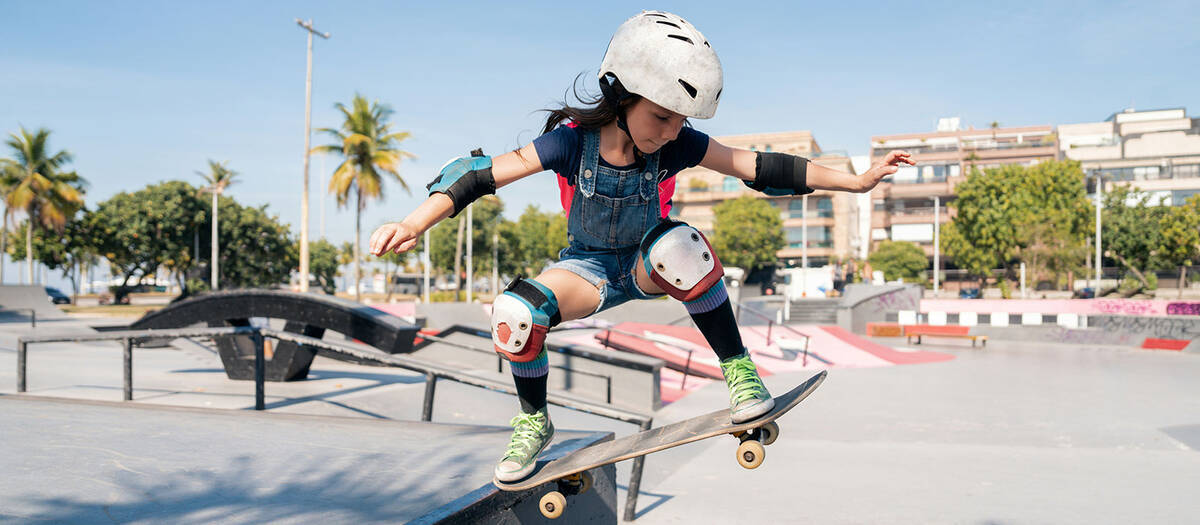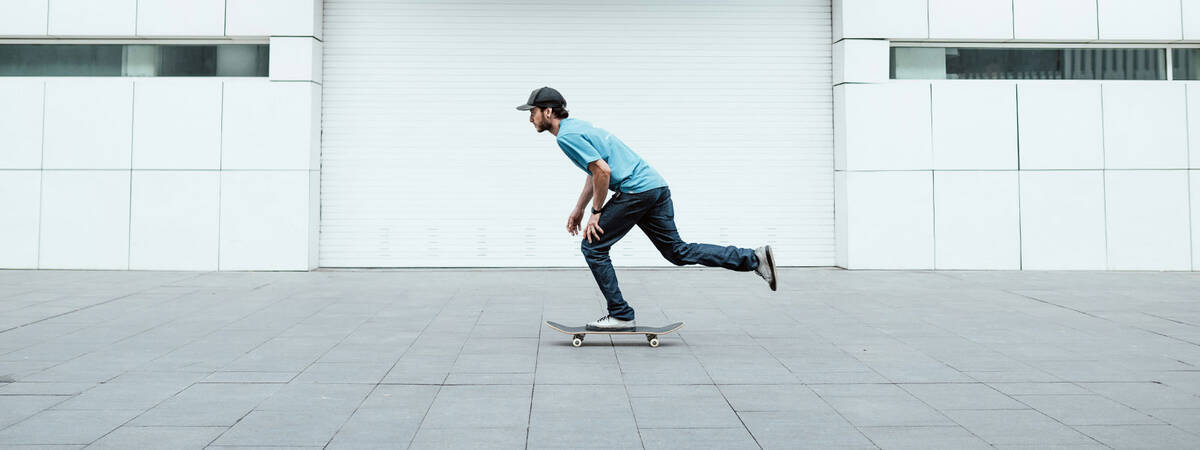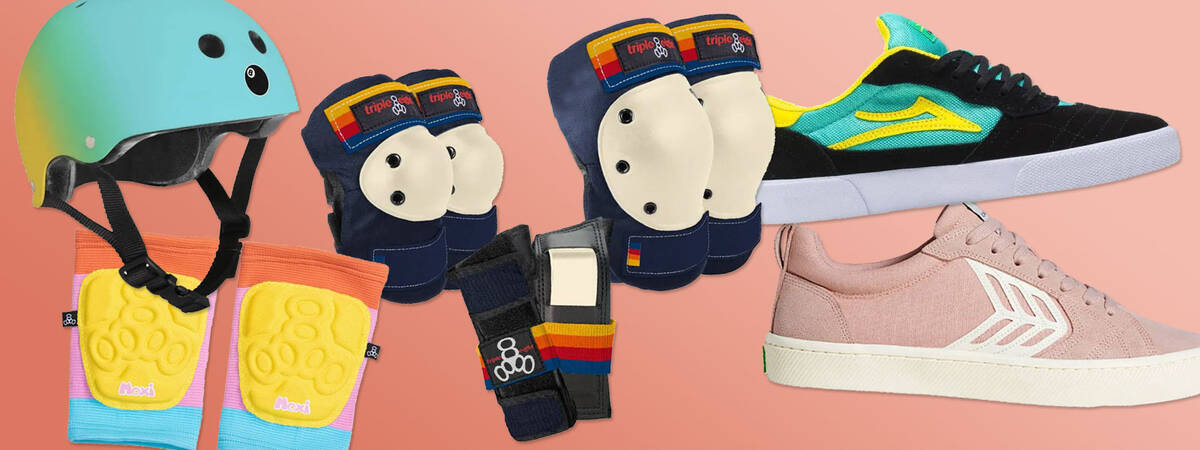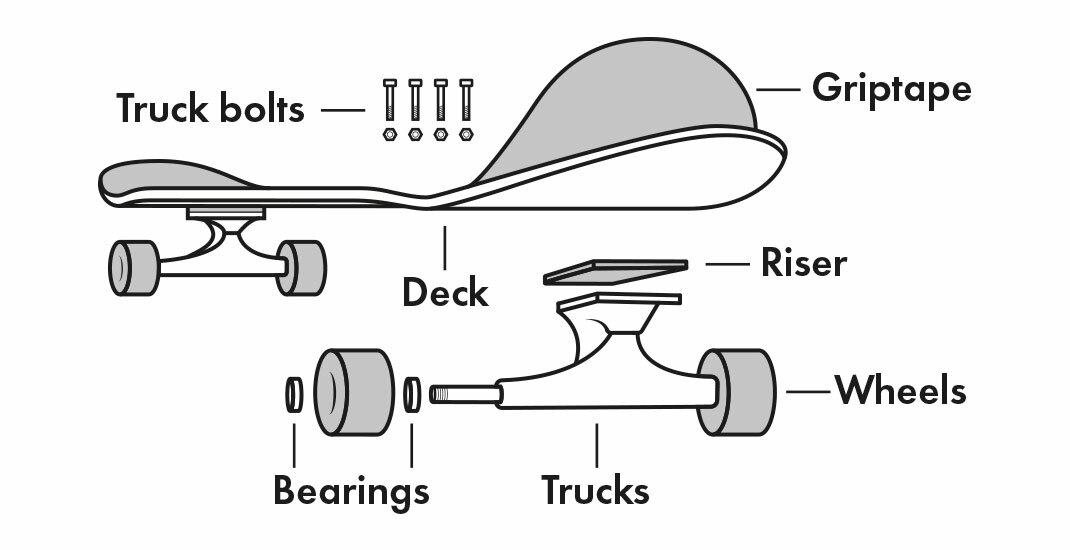Purchasing Skateboards – A Guide for Beginners
It's essential to thoroughly consider the available options when picking a beginner skateboard. The distinct variations among skateboards might be more significant than you'd expect. Through this guide, we aim to illuminate the key queries you might have, whether you're new or returning to skateboarding after a lengthy break.
Overview
Beginner Skateboard Choices

When selecting your initial skateboard, it is vital to think about the skateboarding style you plan to enjoy the most. As you advance, your understanding of your skateboarding preferences will develop, helping you make more precise selections. As a beginner, it is advisable to go with a versatile skateboard that allows learning fundamental tricks and movements. Specialized selections aren't necessary at this point.
As a novice, the decision is between these three primary skateboard types:
- Skateboards: These trick-focused boards, often used for street and park skating, include concave decks with double kick tails and smaller wheels. They offer newcomers a stable platform for beginning their skateboarding experience.
- Cruiser Skateboards: For those mainly interested in commuting or cruising, a cruiser skateboard is an ideal pick. With wider decks and softer wheels, cruisers offer comfort and handling ease, ensuring a smooth ride on uneven terrain. Should cruisers be your preference, review our Guide to Buying Cruiser Skateboards or check out our quality Cruiser Skateboards.
- Longboards: Longboards provide a great option for beginners seeking stability and smoothness. Especially suitable for commuting and downhill riding, they offer a relaxed and steady entry into skateboarding. With styles like longboard dancing, freestyle, or downhill, longboarding provides many opportunities. If you wish to pursue longboarding, see our Guide to Buying Longboards, or explore our selection of Longboards.
This guide emphasizes regular skateboards, ideal for beginner skateboard tricks.
Top Starter Skateboards for Kids & Youth

People often seek beginner boards for girls or cool options for boys, and you'll find a wealth of choices catering to the specific aesthetic tastes of the board's user.
An economical skateboard can suffice during the initial learning phase, but think about whether the skateboard should nurture ongoing growth in skating abilities.
Eventually, a skater will begin executing ollies and tricks, where a firm and responsive deck becomes advantageous to maximize effort. When picking a skateboard for someone at this stage, it's beneficial to consider a complete skateboard at a slightly higher price range, though it's not essential.
The following specs should be noted when selecting a child's complete skateboard:
- Deck width: Choose a skateboard width similar to the child's shoe length. A deck that's too wide might be hard to turn, while an overly narrow one can undermine stability. For further guidance, see our Skateboard Size Guide or refer to additional info later in this guide.
- Wheel hardness: For beginners, wheels should not exceed 92A in hardness. Softer wheels are less likely to come to abrupt stops over small stones or ground cracks, minimizing falls that could dampen the enjoyment for new skateboarders.
- Bushings: For children under 65 kg, choose skateboards with bushings less than 90A hardness. Truck bushing hardness affects the pressure needed to guide the board in a certain way. Softer bushings (lower durometer) simplify steering, while harder bushings (higher durometer) make it more challenging.
When exploring our Complete Skateboards selection, filter the boards by wheel hardness and deck length to find skateboards fitting your needs.
Top Starter Skateboards for Adults

With the proper complete beginner skateboard, adults can start their skateboarding journey regardless of age or past experience. Whether you're entirely new or returning after some time, a pre-built complete skateboard that fits your needs is available. However, it's wise to select carefully, as an adult's weight is likely more than a teenager's.
Use the following specifications to choose an appropriate complete skateboard for an adult beginner:
- Wood type: Opt for a 7-ply maple deck, and try to avoid Chinese maple, which may be softer and less durable, primarily due to quicker tree growth in China. Maple from colder regions, where trees grow slowly, is generally harder and stronger, leading to skateboard decks with more pop and durability.
- Adult skateboard size: For adult beginners, choose a deck width comparable to your shoe length. Selecting a deck wide enough for your feet enhances steering. As a novice, adhere to our general recommendations (presented below). As you advance, you may develop preferences different from these general recommendations.
- Wheel hardness: For wheel hardness, select below 97A. Hard wheels are less effective at absorbing vibrations on rough surfaces, while softer wheels offer reduced responsiveness. While advanced skaters often choose ratings above 97A, beginners typically benefit from softer wheels.
- Bushings: The hardness of truck bushings affects the skate's steering capabilities. Generally, heavier individuals prefer firmer bushings. For those weighing 65 - 79 kg, aim for 85A to 95A bushings, while those over 80 kg should choose 91A bushings or higher.
Resuming Skateboarding as an Adult
Age does not hinder skateboarding! Even if it's been a while, your experience still has merit. The essentials of skateboarding remain unchanged - wood deck, two trucks, and four wheels.
Resuming skateboarding? Get a board that meets your needs and let muscle memory set in. Whether your aim is conquering the skatepark or exploring street spots, pick a skateboard matching your objectives.
For older skateboarders, boards more suited for cruising may be preferable, since many find no point in aiming for intense shredding. For those returning to skating as adults, opt for a broader deck with slightly softer wheels. For occasional tricks, ensure the deck has kick tails on both ends.
Experienced skaters resuming their practice already understand skateboards and parts, so crafting a custom setup fitting your needs is an optimal choice. Browse our Custom Skateboard Builder or view our Skateboard Parts collection to select components for your unique setup.
Selecting the Ideal Skateboard Size for Starters
By consulting our skateboard size chart, you'll find an appropriate size for your initial skateboard. Regarding skateboard dimensions, deck width is the primary focus. Typically, your preferred deck width will shift over time. As you develop interest in various skateboarding styles, you'll choose a deck width that better suits your new interests. However, as a newcomer, we recommend selecting a skateboard size based on your shoe size.
For a child's first skateboard, following the size chart is also recommended.
| Skateboard Width | Recommended Age | Shoe size US | Shoe size UK | Shoe size EU |
| 6.5" | 3 - 5 | 6C - 11C | 5Y - 10Y | 23 - 28 |
| 6.75" | 3 - 5 | 7C - 11C | 6Y - 10Y | 24 - 28 |
| 6.825" | 4 - 6 | 9C - 12C | 8Y - 11Y | 26 - 30 |
| 7.0" | 5 - 7 | 10C - 1 | 9Y - 12Y | 28 - 32 |
| 7.125" | 6 - 8 | 11C - 2 | 10Y - 1 | 29 - 33 |
| 7.25" | 7 - 9 | 12C - 3 | 11Y - 2 | 30 - 34 |
| 7.375" | 8 - 10 | 13C - 4 | 12Y - 3 | 31 - 35 |
| 7.5" | 9 - 11 | 1 - 6 | 13Y - 5 | 32 - 38 |
| 7.625" | 10 - 12 | 2 - 7 | 1 - 6 | 33 - 39 |
| 7.75" | 12 - 14 | 4 - 9 | 3 - 8 | 35 - 42 |
| 7.875" | 12 - 14 | 4 - 9 | 3 - 8 | 35 - 42 |
| 8" & Up | 14 & Up | 9 & Up | 8 & Up | 42 & Up |
Skateboarding Advice for Beginners

Learning skateboarding basics can involve time and practice, but the best advice is straightforward: never give up! Have fun, trust your instincts, and you'll soon navigate the skatepark effortlessly. Below is some practical advice that might help:
Beginner's Skateboard Safety Gear
We advocate skating with helmets and pads, whether you're a beginner or a professional. Fear of falling can impede growth, but good-quality skateboard wrist, knee, and elbow pads, together with a certified skate helmet, can reduce that fear, enhancing performance. Keep safety in mind while enjoying skateboarding with protective gear. This is crucial for any beginner!
Explore our selection of Skateboard Pad Sets and certified Skateboard Helmets.
We also supply top-notch kids' helmets and skateboard gear in our collection of Skateboard Protection for Kids.
Skate Shoes
```htmlInvesting in specialized skate shoes from reputable skate shoe brands is beneficial. You can skate in regular sneakers, but ultimately, opting for authentic skate shoes is advisable.
What benefits do authentic skate shoes offer?
To begin with, they enhance your skating abilities: featuring flat soles and superior grip, they deliver remarkable traction on the skateboard. The soles are crafted to maximize "board feel," boosting your control over the skateboard. This translates to improved responsiveness and greater command over the skateboard.
Moreover, skate shoes are built to withstand the rigours of skateboarding. This activity is notoriously tough on shoes. Durable skate shoes have a longer lifespan and endure many more sessions compared to ordinary sneakers.
Explore our range of Skate Shoes.
Pants for Skateboarding
When it comes to skating, your pants need to be flexible and robust. As a novice, you will experience frequent falls, which will take a toll on your pants. Your pants should also allow for unrestricted movement. Opt for skate pants crafted from stretchy material and/or with a relaxed fit.
Pants that don’t impede your motion and are manufactured from tough fabric are well-suited for skating. Many beloved skate pants are actually workpants. Check out our pant collection to find your new dedicated Skate Pants, and don't miss our excellent collection of Skater Belts!
Tightening Trucks
The ability to manoeuvre your skateboard depends on how tight or loose the trucks are. Your skateboard should react to your leaning direction while riding. If it doesn't, try loosening the trucks a bit. On the other hand, if maintaining control is challenging because the skateboard shifts excessively, consider tightening the trucks. Adjusting the kingpin nut can substantially change how your skateboard rides!
Given that skaters vary in height and weight, the pressure they exert on the trucks differs. Thus, there's no fixed truck tightness, making it worthwhile to experiment and discover that perfect balance for stable and consistent riding.
View this video to learn how to adjust your skateboard trucks, and remember, a Skate Tool is a cost-effective, enduring investment.
The Components of a Skateboard – Understanding Skateboard Parts

Creating your own custom skateboard is the ideal choice for dedicated skaters. Even if purchasing a beginner complete, it's beneficial to have knowledge about skateboard parts - the components of a skateboard.
There are several good reasons for beginners to opt for a custom skateboard. Whether you're drawn to the art on a standalone deck or want the highest quality trucks, building your skateboard enables you to select the exact components you desire.
If applying grip tape or attaching wheels seems daunting, try our Custom Skateboard Builder. Our team, passionate about skateboarding, will assemble the complete skateboard for you, ensuring it's ready for use right out of the box.
Here’s a concise overview of the different skateboard parts:
Decks for Skateboards
Skateboard decks are generally composed of stacked layers of wood, referred to as ply. Most trick skateboard decks are crafted from 7-ply maple. The finest beginner skateboard decks use harder types of maple for added durability. The deck stands as one of the critical components of a skateboard, serving as the basis for performing tricks and manoeuvres.
Explore our in-depth Guide to Buying Skateboard Decks, or view our extensive collection of Skateboard Decks.
Trucks for Skateboards
Located under the skateboard deck, skateboard trucks consist of metallic T-shaped pieces to which the wheels attach. Truck positioning dictates the skateboard's steering and intricately influences its manoeuvrability and riding characteristics.
For detailed insights on skateboard trucks, including specifics on bushings, hangers, and baseplates, refer to our elaborate Skateboard Truck Buying Guide. If you already have a preference, browse our wide selection of Skateboard Trucks.
Wheels for Skateboards
Crafted from polyurethane, skateboard wheels vary in size, hardness, and shape. They significantly impact the skateboard's smoothness, speed, and grip.
New skaters should pay attention to wheel hardness, always rated on the durometer scale. Here are our basic skateboard wheel suggestions for novices:
- Kids should aim for wheels with a durometer of 92A or less.
- Adult beginners should select wheels with a durometer of 97A or less.
For those eager to master tricks, beginners are urged to choose a diameter within the 52 - 54 mm bracket.
For a complete understanding of skateboard wheels, consult our Guide to Buying Skateboard Wheels. Feel free to view our entire selection of Skateboard Wheels. To streamline your search, filter the wheels by hardness and other important features to find your perfect match.
Bearings for Skateboards
Positioned within the cores of the wheels, skateboard bearings allow the skateboard to roll smoothly with minimal drag, ensuring efficient wheel rotation. Bearings offer various ABEC ratings, from ABEC 1 to ABEC 9, with higher numbers suggesting smoother performance. However, in skateboarding, factors like the material's calibre, lubrication, and upkeep impact bearing efficiency more than ABEC ratings alone. As a beginner, the ABEC rating shouldn't be your focal point.
If wheel spinning efficiency decreases, refer to our guide on How to Clean and Maintain Bearings.
Explore our full range of Skateboard Bearings, or delve into the details with our comprehensive Bearing Guide.
Griptape for Skateboards
Skateboard griptape, a gritty, sandpaper-like material, is placed on the upper side of the skateboard deck. It aids in board control and prevents foot slippage. When your feet slide along the deck's top, the griptape creates friction. Combined with a quick pop of the kicktail to the ground, this sliding action elevates the board higher during ollies.
Griptapes are available in various colours, with or without graphics, and even in clear options. Browse through our Skateboard Griptape selection and explore the options!
If you need to apply griptape,
